The Apple iPhone 6s and iPhone 6s Plus Review
by Ryan Smith & Joshua Ho on November 2, 2015 8:00 AM EST- Posted in
- Smartphones
- Apple
- Mobile
- SoCs
- iPhone 6s
- iPhone 6s Plus
System Performance Cont'd
Moving on towards our more GPU-bound workloads, we use our standard test suite of benchmarks like GFXBench and 3DMark to get a good idea for performance. Unfortunately, due to the move to iOS 9 the Unity engine version used in Basemark X is no longer working so for now we’re left with 3DMark and GFXBench. There is also Basemark OS II’s graphics test, but this is embedded in a larger benchmark with CPU and storage performance tests.

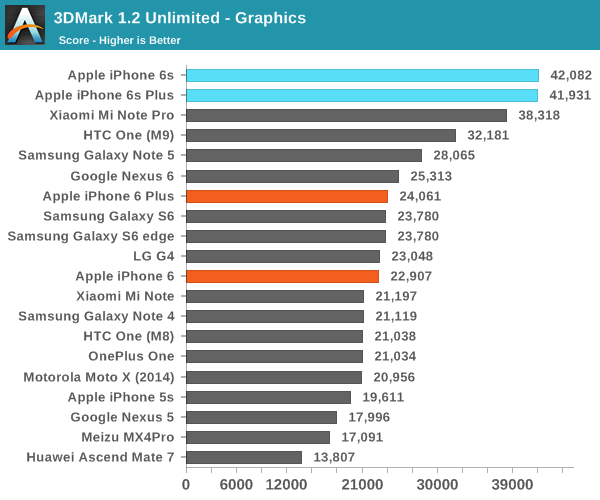
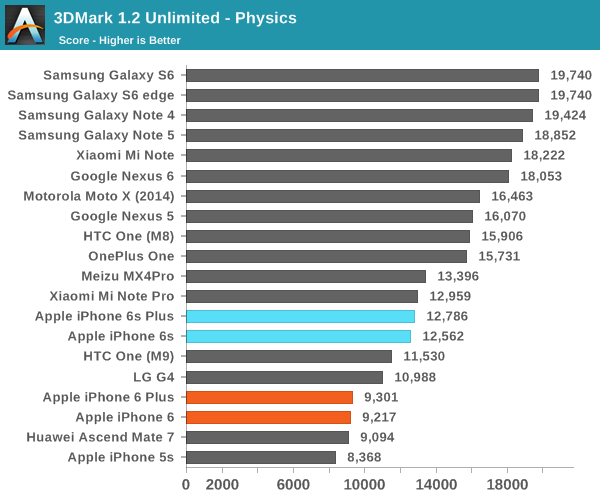
As always with 3DMark, there are some issues in the data structures used. Due to the data dependencies present within the physics test, it is necessary for the CPU to stall for data to be committed to memory before continuing on to the next portion of the test instead of executing instructions in parallel. This strongly reduces the practical performance of the CPU because the architecture is primarily focused upon instruction-level parallelism to deliver major performance gains. However, due to the strong showing in graphics performance the iPhone 6s’ still manage to take the lead.
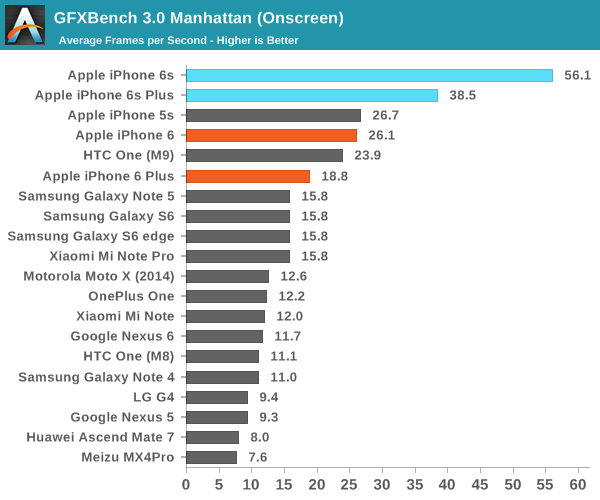
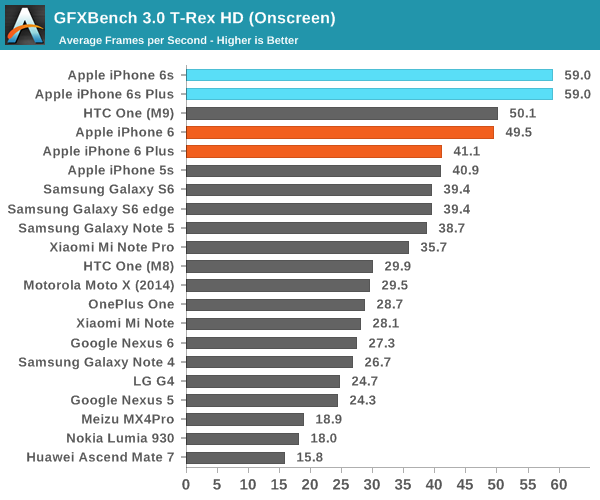
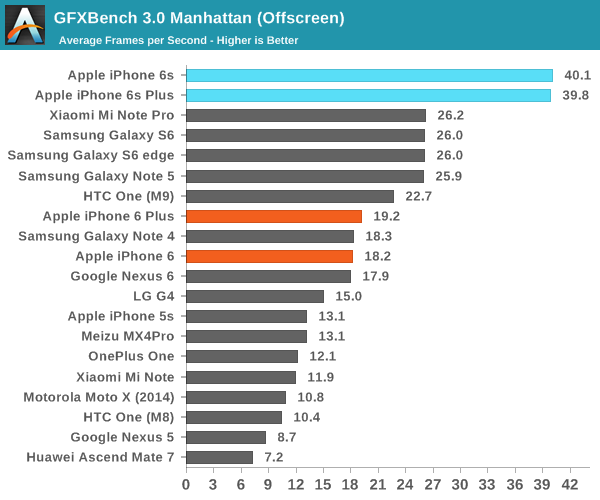

In GFXBench, the A9 SoC just shows absurd performance. It’s strange to think about how the iPad Air 2’s GPU seemed incredibly quick at the time but with the A9 Apple has surpassed that level of performance in their smartphone SoCs. The move to a new generation of PowerVR GPU IP, in addition to the move to a FinFET process node are really the drivers for this kind of performance improvement.
Overall, the Apple A9 SoC is the best SoC in any phone shipping today. In cases like web browsing, gaming, and even just going through the UI it’s quite evident that this new SoC is a major factor in improving performance and smoothness across the board. Something as simple as visiting some popular tech websites will show this, which really goes to show how much “specs” still matter due to their influence on user experience.
NAND Performance
At this point is almost goes without saying that storage performance is important, but in a lot of ways the testing here is still in its early days. In the case of the iPhone 6s we’ve discussed what distinguishes its storage solution from others in this industry, but for those that are unaware the iPhone 6s uses PCIe and NVMe instead of a UFS or eMMC storage solution. In a lot of ways, this makes the storage on board closer to the SSD that you might find in a more expensive PC but due to PCB limitations you won’t necessarily see the enormous parallelism that you might expect from a true SSD. In the time since the initial results we've found that all of our review units use Hynix-supplied NAND. In order to test how this storage solution performs, we use Eric Patno’s storage test which allows for a simple storage test comparable to AndroBench 3.6.
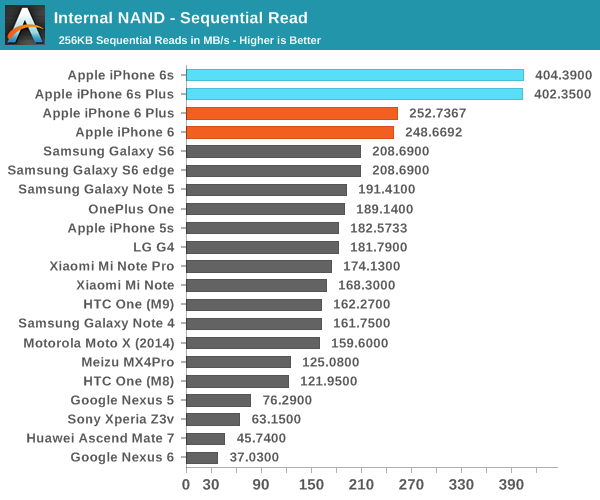
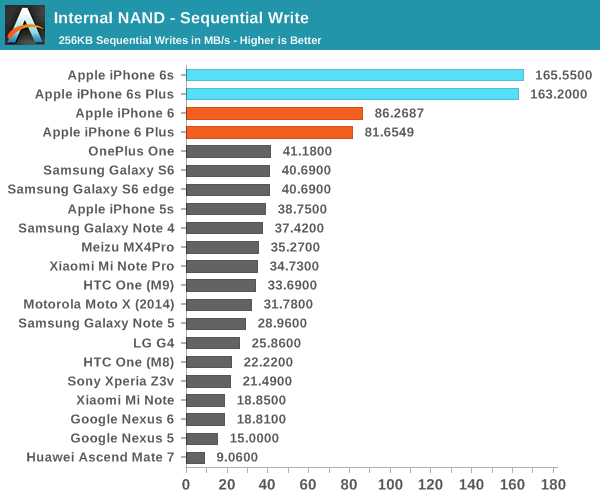
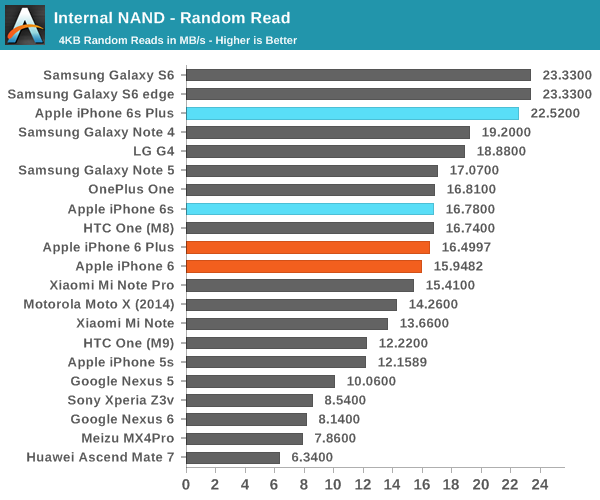
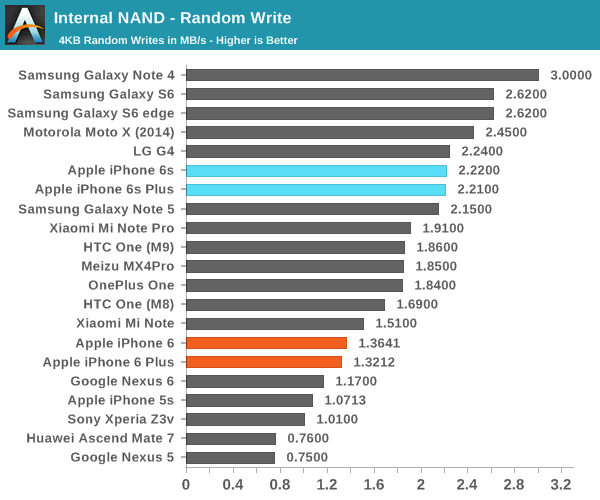
Here, we can really see the enormous performance improvements that result from a combination of TLC NAND with an SLC cache, along with the new NVMe protocol which allows for low CPU overhead and removes architectural bottlenecks to storage performance. This should allow for things like faster burst photos and faster app updates. Downloading and updating apps on the iPhone 6s feels noticeably faster than it is on the iPhone 6, to the extent that small apps feel like they install almost instantly when I’m on a WiFi connection fast enough to saturate storage bandwidth.










531 Comments
View All Comments
michael2k - Monday, November 2, 2015 - link
What's wrong is that you won't read the article.vFunct - Monday, November 2, 2015 - link
There really isn't a better cameraphone than the iPhone.I haven't read any review that said any camera was better than the iPhone.
artificialintel - Monday, November 2, 2015 - link
I certainly have read such reviews. There's quite a number of camera phones that are significantly better at taking pictures than an iPhone could possibly be, because they attach the phone to basically a full consumer-level quick shot camera with vastly larger apertures, optical zoom, etc. The iPhone has a very good camera, arguably the best of its kind, but I've definitely read reviews that said other cameras were better.V900 - Tuesday, November 3, 2015 - link
Oh yeah, how can we forget about all the phones with optical zoom out there! Like the ehm... Ehm. Could you name one? Samsung made one a few years ago think!The whole concept of camera-phones doesn't really make sense anyways.
The best smartphone cameras, like the iPhone and a few competitors, can come close to the kind of pictures you get with a dedicated point and shoot camera, but cellphones will never take pictures as good as a dedicated camera. (Not unless they more or less jam a phone into a camera!) Any photographer will tell you that.
It's not something that can be solved with bigger or better sensors, it's a matter of physics. Cameras suck up photons in the form of light, the more the better the picture. And the tiny lens in a smartphone will never be able to compete with a dedicated camera, with lenses many times bigger.
Shadow7037932 - Monday, November 2, 2015 - link
Oh, are you talking about the DxOMark rating? No one knows exactly how they derive those ratings.halcyon - Tuesday, November 3, 2015 - link
DXOMark's weighting algorithm is much more public than any of this subjective hand-waving that passes for "testing" even here at Anandtech:http://www.dxomark.com/Reviews/Detailed-computatio...
http://www.dxomark.com/About/In-depth-measurements...
http://www.dxomark.com/About/Lens-scores/DxOMark-S...
Sorry, but for camera tests. Anandtech is NOT the place. Not even smartphone camera tests.
vFunct - Tuesday, November 3, 2015 - link
Which is why you should never trust DXOMark, because quality is supposed to be subjective.A good critic is better than an algorithm.
vFunct - Tuesday, November 3, 2015 - link
You never judge a photo by how many numbers it adds up to. You shouldn't just a camera that way either.People that think camera quality is an objective experience don't know anything about photography and cameras.
dangerzone - Monday, November 2, 2015 - link
"Professionals have reviewed the camera really poorly"Hardly. It's no longer the top smartphone camera, that's a true and fair statement because the top Android phones have come out swinging with cameras this year. But pretty much every review still calls it great.
daveedvdv - Tuesday, November 3, 2015 - link
Also, in a "blind evaluation test" on an Android news site the iPhone 6S was preferred against a crop of modern Android cameras. (http://www.androidauthority.com/blind-camera-shoot...That's just one survey, but its bias was certainly no pro-iPhone.